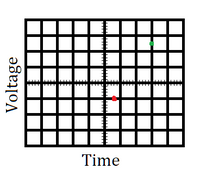
This quiz is about reading off the information on the oscilloscope grid. Voltage is vertical, and the reading will always be in divisions and hash marks. Four hash marks divide each division into five smaller intervals, to make it easier to measure a fraction of a division. The voltage division number in the reading will be 0 through 8 -- the bottom line is zero, the top line is 8, and the hash mark will be 0 to 4.
The horizontal axis is time, and the time scale is (hopefully) properly calibrated. There are ten divisions total. Each division is divided up by five hash-marks on the central horizontal line, to make measuring the time easier. If measured from the left side, the central line would be five divisions away, and would be div 5.
One sets the voltage and time units per division on the oscilloscope. The time knob is visible in the introductory figures. The voltage isn't calibrated, though. It will always be referred to in div.
How much time does the green dot occur after the red dot? The scale is 5 ms/div.

Trending nowThis is a popular solution!
Step by stepSolved in 2 steps

- The distance of a galaxy from our solar system is 10 Mpc. (a) What is the recessional velocity of the galaxy? (b) By what fraction is the starlight from this galaxy red shifted (that is, what is its z value)?arrow_forwardThe nearest neutron star (a collated star made primarily of neutrons) is about 3.00 1018 m away from Earth. Given that the Milky Way galaxy (Fig. P1.81) is roughly a disk of diameter 1021 m and thickness 1019 m, estimate the number of neutron stars in the Milky Way to the nearest order of magnitude. Figure P1.81arrow_forwardWhy is it reasonable to suspect that travel between stars is nearly impossible?arrow_forward
- Discuss whether you think there are limits to what humans can understand about the laws of physics. Support your arguments.arrow_forwardDescribe the basic features of the “lighthouse” model of a pulsar, and indicate how they combine to give rise to the observed sharply pulsed radio emission from these sources.arrow_forwardOur solar system orbits the center of the Milky Way galaxy. Assuming a circular orbit 30,000 ly in radius and an orbital speed of 250 km/s, how many years does it take for one revolution? Note than this is approximate, assuming constant speed and circular orbit, but it is representative of the time for our system and local stars to make one revolution around the galaxy.arrow_forward
- The story of a process makes the facts easier to remember, but easy recall is not the true goal of the scientist. What is the real value of understanding a scientific process?arrow_forwardIf a GUT is proven, and the four forces are unified, it will still be correct to say that the orbit of the moon is determined by the gravitational force. Explain why.arrow_forwardWhen you are flying in a commercial jet, it may appear to you that the airplane is stationary and Earth is moving beneath you. Is this point of view valid? Discuss briefly.arrow_forward
 Physics for Scientists and Engineers: Foundations...PhysicsISBN:9781133939146Author:Katz, Debora M.Publisher:Cengage Learning
Physics for Scientists and Engineers: Foundations...PhysicsISBN:9781133939146Author:Katz, Debora M.Publisher:Cengage Learning
 An Introduction to Physical SciencePhysicsISBN:9781305079137Author:James Shipman, Jerry D. Wilson, Charles A. Higgins, Omar TorresPublisher:Cengage Learning
An Introduction to Physical SciencePhysicsISBN:9781305079137Author:James Shipman, Jerry D. Wilson, Charles A. Higgins, Omar TorresPublisher:Cengage Learning Horizons: Exploring the Universe (MindTap Course ...PhysicsISBN:9781305960961Author:Michael A. Seeds, Dana BackmanPublisher:Cengage Learning
Horizons: Exploring the Universe (MindTap Course ...PhysicsISBN:9781305960961Author:Michael A. Seeds, Dana BackmanPublisher:Cengage Learning Foundations of Astronomy (MindTap Course List)PhysicsISBN:9781337399920Author:Michael A. Seeds, Dana BackmanPublisher:Cengage Learning
Foundations of Astronomy (MindTap Course List)PhysicsISBN:9781337399920Author:Michael A. Seeds, Dana BackmanPublisher:Cengage Learning Stars and Galaxies (MindTap Course List)PhysicsISBN:9781337399944Author:Michael A. SeedsPublisher:Cengage Learning
Stars and Galaxies (MindTap Course List)PhysicsISBN:9781337399944Author:Michael A. SeedsPublisher:Cengage Learning





